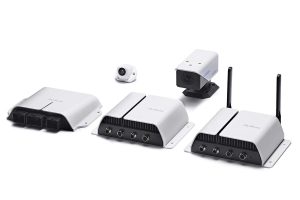
Autonomous Technology in Boating
Published on March 28, 2023As technology continues to expand and integrate with nearly every facet of life, marinas and boatyards should expect to see technological advances continue to catapult the recreational boating industry into the future.
Shipbuilder HD Hyundai’s start-up company Avikus, which specializes in developing autonomous navigation solutions for vessels, plans to release NeuBoat this year, aimed at helping people navigate leisure boating and to make better decisions based on their surroundings. Its higher-level solution can actually control a boat, help to avoid collisions, and dock the boat. The name combines the words “neuron” and “boat.”
Industry Rollouts
In January, Avikus attended the tech event CES®, produced by the Consumer Technology Association, where NeuBoat was selected as an Innovation Award Honoree in the category of Vehicle Tech and Advanced Mobility. NeuBoat’s Level.2 autonomous navigation for recreational boats was also demonstrated recently at the Fort Lauderdale International Boat show.
Avikus has a similar product, HiNAS, used for the commercial shipping industry. HiNas 2.0 was recently tested in the world’s first ocean crossing using autonomous navigation technology. “We’re the only marine company in the world that is doing autonomous technology for ships and for boats” said Carl Johansson, vice president of business development at Avikus .

Assistant Camera, Navigation Assistant Camera, Engine
Interface Unit, Auto Pilot Unit, and Object Recognition Unit.
He added that every feature they have, at least from the navigational safety point of view, is implemented on a commercial ship first. Here, the professionally trained captain and crew can test the systems and suggest improvements.
Focusing on the Fun of Boating
Johansson called NeuBoat “a stepping stone to enhance the boating experience.” It will eventually enhance the experience for every kind of boating activity, from fishing to wakeboarding.
Of course, it is also aimed at improving safety.
“It doesn’t get tired,” he said, comparing the technology to humans. “It’s pretty much always human error in the navigation. There’s many, many reasons for that, but most of it is either that you fail to see something or that you failed to take the correct action.”
Avikus’s technology, he said, will help with this. “We really hope to remove some of the obstacles that prevent people from boating,” he added.
When asked how leisure boaters can build and enhance their maritime skills if autonomous systems are doing all the thinking and acting for them, Johansson explained the technology can actually become the teacher, educating boaters about navigation while the system navigates properly around markers and obstructions in the waterways.
“The robots aren’t taking over in that way,” he said, comparing the chatter about the threat of AI to that of computers when they came out and some thought they would eliminate the need for humans. “We try to be very reasonable about what we think the system will be able to do. We’re not going to push anything out too quickly.”
Two Systems, Two Levels
There are two systems and two levels available for both leisure boats and commercial ships. The systems include an autonomous navigation system and an autonomous docking system. While the boating industry uses five levels to differentiate what these autonomous products can do, Avikus currently offers only two levels. There’s little doubt the levels will increase as the data collection drives system revisions.
Level.1, or low-level autonomy, provides a 360-degree view of what’s occurring around the vessel. It helps the operator see things they want to avoid hitting. The boat operator still needs to operate the boat.

NeuBoat can provide route planning, navigation assistance, and docking assistance
Level.2 provides autonomous control, including collision avoidance and auto docking. Johansson said the Level.2 solution is comparable to the Tesla today. The operator may not need to constantly have their hands on the wheel, but they shouldn’t be far from it.
The company plans to update to level 3. So, while the operator won’t be able to sleep while using the technology, they also aren’t required to have their hands on the wheel.
To date, the product is not available to leisure markets, but it and its apps will be this year.
Autonomous enhancements for leisure boats will soon include apps that can search and navigate toward the nearest sunset and find and navigate to where fish are plentiful for fishing.
Pricing and Competition
When asked about competition, Johansson said for the leisure boating market, there may be about five competitors in the general autonomous technology, but none that have announced specifically what they’re doing.
Pricing is still being considered. He said Level.1 NeuBoat may be retrofitted into an existing boat. Level.2, however, will most likely be for new boats, so pricing will likely go through boat builders; future versions of Level.2 may be retrofittable.
Autonomous technology is not new. Johansson said such systems include input from things like charts and waterway obstacles combined with the desired decision for how things actually occur on the boat. For instance, a decision is made between whether a user wants a vessel to know if it might collide with something or have the boat stop the collision.
The input is things like charts and waterway obstacles. With regard to the AI decision, developers had to take into account unplanned situations. After all, the sea is chaotic, unlike the relative predictability of roads. AI interprets information from situational awareness from stage one. In the meantime, as Avikus prepares to unveil NeuBoat, research and data collection to make system improvements continue at a rapid pace.
| Categories | |
| Tags |





